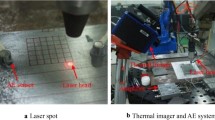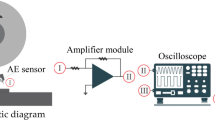Abstract
Acoustic emission (AE) is widely used in the application of grinding monitoring, but few studies have been conducted on the quantitative relationship between the amplitude of AE signal and grinding parameters. In order to obtain the quantitative description and solve the problem of threshold recommendation in using AE signal to monitor grinding process, this paper proposes an amplitude model of AE signal of face grinding based on experimental and theoretical researches. The exponential relationship between grinding force and amplitude of AE signal under a certain condition of the fixed grinding wheel speed is achieved by experimental study. By establishing the theoretical model of the grinding force and cutting depth, the mathematical model between the amplitude of AE signal and the grinding parameters of face grinding is obtained indirectly. The experimental results prove the validity of the amplitude model of AE signal and its effectiveness in the automatic recommendation of the threshold for collision detection in face grinding.
Similar content being viewed by others
References
Kwak JS, Ha MK (2004) Neural network approach for diagnosis of grinding operation by acoustic emission and power signals. J Mater Process Tech 147:65–71
Wang Z, Willett P, DeAguiar PR, Webster J (2001) Neural network detection of grinding burn from acoustic emission. Int J Mach Tool Manu 41:283–309
Nakai ME, Aguiar PR, Guillardi H, Bianchi EC, Spatti DH, D’Addona DM (2015) Evaluation of neural models applied to the estimation of tool wear in the grinding of advanced ceramics. Expert Syst Appl 42:7026–7035
Liao TW, Tang FM, Qu J, Blau PJ (2008) Grinding wheel condition monitoring with boosted minimum distance classifiers. Mech Syst Signal Process 22:217–232
Yang ZS, Yu ZH (2011) Grinding wheel wear monitoring based on wavelet analysis and support vector machine. Int J Adv Manuf Technol 62:107–121
Yang ZS, Yu ZH (2013) Experimental study of burn classification and prediction using indirect method in surface grinding of AISI 1045 steel. Int J Adv Manuf Technol 68:2439–1449
Zhang DX, Bi G, Sun ZHJ, Guo Y (2015) Online monitoring of precision optics grinding using acoustic emission based on support vector machine. Int J Adv Manuf Technol 80(5–8):761–774
Tawakoli T (2008) Developments in grinding process monitoring and evaluation of results. Int J Mech Manuf Syst 1:307–320
Jiang C, Song Q, Guo DB, Li HL (2014) Estimation algorithm of minimum dwell time in precision cylindrical plunge grinding using acoustic emission signal. Int J Precis Eng Manuf 15:601–607
Han XS, Wu TY (2013) Analysis of acoustic emission in precision and high-efficiency grinding technology. Int J Adv Manuf Technol 67:1997–2006
Sun J, Qin F, Chen P (2016) A predictive model of grinding force in silicon wafer self-rotating grinding. Int J Mach Tools Manuf 109:74–86
Malkin S, Guo C (2008) Grinding technology: theory and applications of machining with abrasives, second edn. Industrial Press, New York
Wang D, Ge P, Bi W, Jiang J (2014) Grain trajectory and grain workpiece contact analyses for modeling of grinding force and energy partition. Int J Adv Manuf Technol 70(9–12):2111–2123
Perveen A, Rahman M, Wong YS (2014) Modeling and simulation of cutting forces generated during vertical micro-grinding. Int J Adv Manuf Technol 71:1539–1548
Guizhi X, Zhentao S, Xiaomin S, Yao W, Jianwu Y (2011) Grinding force modeling for high-speed deep grinding of engineering ceramics. J Mech Eng 47(11):169–176 (in Chinese)
Sharp KW, Miller MH, Scattergood RO (2000) Analysis of the grain depth of cut in plunge grinding. J Int Soc Precis Eng Nanotechnol 24:220–230
Young HT, Liao HT, Huang HY (2007) Novel method to investigate the critical depth of cut of ground silicon wafer. J Mater Process Technol 182(1):157–162
Park HW, Liang SY (2008) Force modeling of micro-grinding incorporating crystallographic effects. Int J Mach Tools Manuf 48(15):1658–1667
Kwak JS, Song JB (2001) Trouble diagnosis of the grinding process by using acoustic emission signals. Int J Mach Tools Manuf 41(3):899–913
Zylka L, Burek J, Mazur D (2017) Diagnostic of peripheral longitudinal grinding by using acoustic emission signal. Adv Prod Eng Manag 12(3)
Mei YM, Yu ZH, Yang ZS (2017) Experimental investigation of correlation between attrition wear and features of acoustic emission signals in single-grit grinding. Int J Adv Manuf Technol 93(5–8):2275–2287
Wang JJ, Feng PF, Zha TJ (2017) Process monitoring in precision cylindrical traverse grinding of slender bar using acoustic emission technology. J Mech Sci Technol 31(2):859–864
Acknowledgments
Thanks are due to Shanghai Machine Tool Works Co., LTD for its technical support.
Funding
The authors would like to thank the financial support from National Science and Technology Major Project of China (No. 2016X04004003).
Author information
Authors and Affiliations
Corresponding author
Rights and permissions
About this article
Cite this article
Li, J., Wang, X., Shen, N. et al. Modeling of acoustic emission based on the experimental and theoretical methods and its application in face grinding. Int J Adv Manuf Technol 98, 2335–2346 (2018). https://doi.org/10.1007/s00170-018-2383-1
Received:
Accepted:
Published:
Issue Date:
DOI: https://doi.org/10.1007/s00170-018-2383-1




